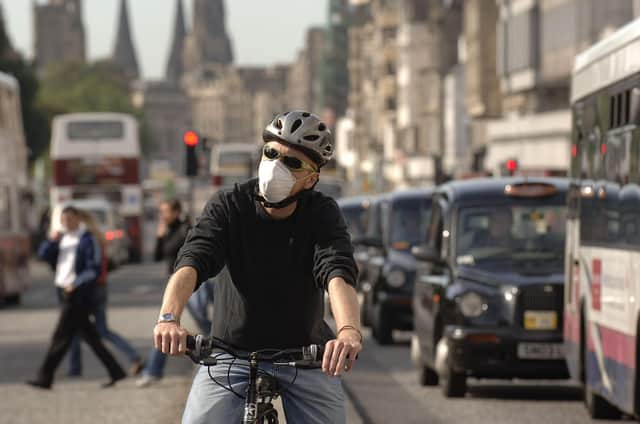Toxic traffic fumes in Scotland stay within safety levels for the first time thanks to Covid lockdown


Average concentrations of nitrogen dioxide and particulate matter in Scotland’s dirtiest streets have been exceeding maximum safe levels since they were set out by the EU in 2010.
But the latest figures show a drop in the numbers of vehicles on roads during the first lockdown, which began last March, reduced emissions for the whole year sufficiently to stay below the statutory limit.
Advertisement
Hide AdAdvertisement
Hide AdEnvironmental campaigners say the findings show a clear link between car journeys and pollution, and action must be taken to keep levels permanently down.
Air pollution has been named as the biggest human killer globally, overtaking heart disease, poor diet and smoking as the leading preventable cause of premature death.
Studies have shown exposure is linked to respiratory illnesses such as asthma and chronic lung disease, as well as cancer, heart attacks, strokes and even dementia.
It can also lead to low birth weight and delayed development in babies whose mothers were exposed while pregnant.
Children, the elderly and people with pre-existing health problems are also disproportionately affected.
Estimates suggest 2,500 Scots die early each year as a result, part of 40,000 across the UK and 6.5 million globally.
Closure of schools and offices and government instructions to stay at home, brought in last spring, saw the number of vehicles on roads plummet.
The measures resulted in steep drops in quantities of poisonous fumes, most noticeably on the busiest commuter roads in Scotland’s largest cities.
Advertisement
Hide AdAdvertisement
Hide AdRoutes such as Hope Street in Glasgow and Edinburgh’s Nicolson Street saw some of the most dramatic reductions.
But contaminants swiftly rose to former levels when restrictions were loosened.
Gavin Thomson, air pollution campaigner for Friends of the Earth Scotland, said: “It’s a huge pity that it took a deadly pandemic to bring our air quality within legal limits.
“Scotland’s car-choked transport system was brought to a halt in spring, and this is why our annual averages of pollution are much lower than previous years.
“Any improvements in air quality in Scotland have been short-lived with traffic quickly returning to pre-pandemic levels.
“We need to remember that pollution damages our health through long-term exposure, such as living near a main road throughout your childhood.
“The reduced pollution for a couple of months during the strictest lockdown is unlikely to have many long-term health benefits.”
He called for stronger efforts to clean up the air and protect public health.
Advertisement
Hide AdAdvertisement
Hide AdHe added: “The government and councils must seize this moment to rethink how we plan our towns and cities, and how we move around.
“Temporary improvements in air quality arrived at an enormous cost to our communities and societies.
“There was no intention or concerted political action to reduce emissions, which is why the falls were not maintained when restrictions eased.
“We need a just and green recovery, including investment in our public transport and more options for safe walking and cycling, to improve the air we breathe permanently.”
10 dirtiest streets for nitrogen dioxide 2020
The European Ambient Air Quality Directive set a limit for nitrogen dioxide (NO2) of 40 microgrammes per cubic metre (µg/m3). The deadline for this limit to have been met was 2010.
Glasgow Hope Street – 35.87µg/m3
Dundee Lochee Road -31.09µg/m3
Perth Atholl Street – 27.62µg/m3
Dundee Seagate – 27.60µg/m3
Inverness Academy Street – 26.99µg/m3
Edinburgh Nicolson Street – 26.50µg/m3
Falkirk West Bridge Street – 25.96µg/m3
Edinburgh St John's Road – 25.77µg/m3
Glasgow Dumbarton Road – 25.29µg/m3
Aberdeen Wellington Road 24.99
10 dirtiest streets for fine particles
The Scottish annual statutory standard for particulate matter (PM10) is 18 microgrammes per cubic metre (µg/m3). The deadline for this standard to have been met was 31 December 2010.
Edinburgh Salamander Street – 15.93µg/m3
Falkirk Main Street Bainsford – 12.20µg/m3
North Ayrshire Irvine High Street – 11.35µg/m3
Aberdeen Wellington Road – 11.29µg/m3
Fife Cupar – 11.28µg/m3
Edinburgh Queensferry Road – 11.16µg/m3
Aberdeen Anderson Drive – 11.12µg/m3
Glasgow Byres Road – 10.84µg/m3
Aberdeen King Street – 10.74µg/m3
West Lothian Broxburn – 10.58µg/m3
A message from the Editor:
Thank you for reading this article. We’re more reliant on your support than ever as the shift in consumer habits brought about by coronavirus impacts our advertisers.
If you haven’t already, please consider supporting our trusted, fact-checked journalism by taking out a digital subscription. Visit https://www.scotsman.com/subscriptions now to sign up.
Comments
Want to join the conversation? Please or to comment on this article.